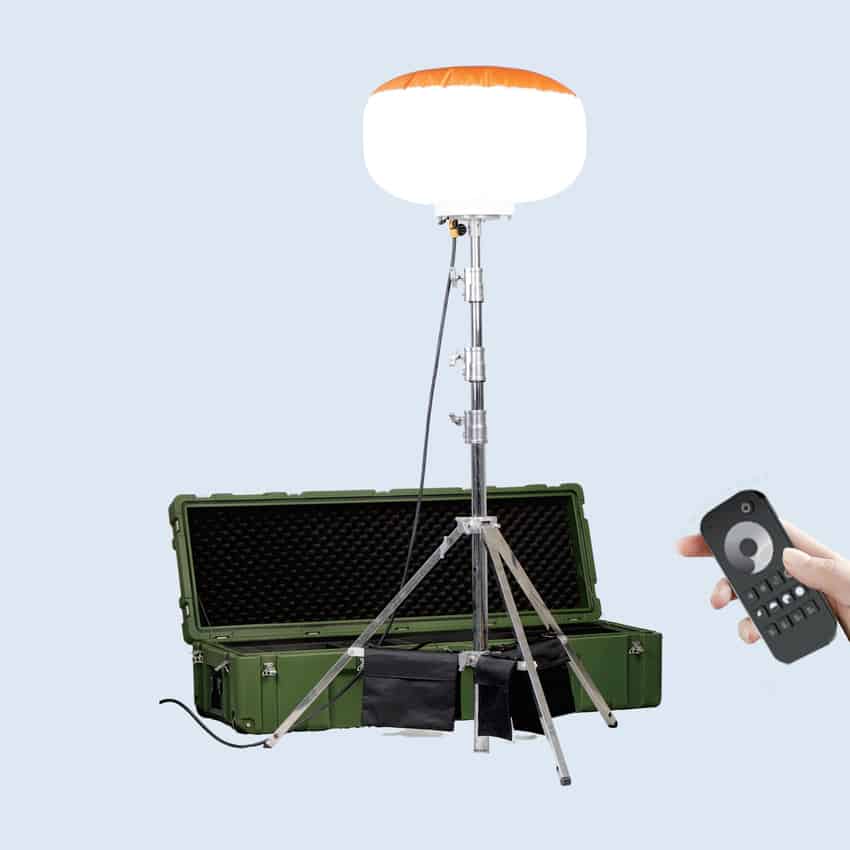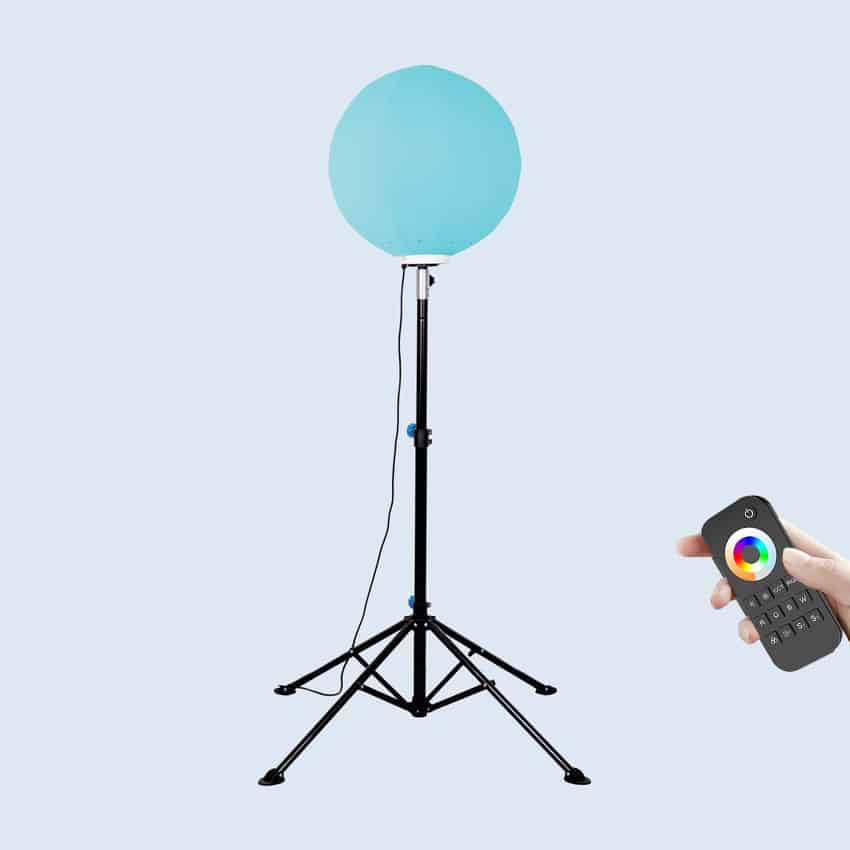Introduction

There are various types of lighting solutions that can be used for construction, depending on the specific needs of the project. Some popular types of lighting include incandescent lighting, halogen lighting, fluorescent lighting, and LED lighting.
Incandescent lighting are the traditional type of lighting bulb that uses a filament in an inert gas to produce light.
Halogen lights use a tungsten filament in halogen gas to produce a bright light with low energy consumption. Fluorescent lights are more energy-efficient than incandescent and halogen lights and use a low-pressure mercury vapor, coated with phosphors, to produce light.
LED bulbs on the other side are the most energy-efficient type of light available and use semi-conductors to produce light.
We will take a closer look and compare each of these types in order to determine which might be the best solution for a construction project.
Incandescent versus Halogen
Incandescent lights produce a warm light and have been used as a lighting source for many years, but they are not very energy-efficient and can be quite expensive in the long run.
Incandescent lights are the least energy-efficient option and the light produced is often not very bright. Halogen lights produce a brighter and whiter light and are slightly more energy-efficient than incandescent lights.
The incandescent lights are mostly used for decorative lighting and have a life span of around 1000-2000 hours. Halogen lights can last up to 3000 hours and are more suitable for task lighting.
When it comes to construction lighting, halogen lights are the better choice due to their energy efficiency and long life span. They however have a higher initial cost and may not be suitable for all projects. Both of them produce glaring light, which can cause eye fatigue.
Fluorescent and LED Lights

Fluorescent lights are more energy-efficient than incandescent and halogen lights and produce a more even light with no glaring. They are also cheaper to use in the long run than incandescent or halogen lights. The downside is that they have a longer time to reach full brightness and can flicker or buzz if the voltage is too low.
LED lights produce a bright, even light and are the most energy-efficient type of lighting available. They have a long life span and don’t require much maintenance. Fluorescent is not a suitable option for outdoor lighting as the light is too dim and the life span of fluorescent lights is shorter than LED.
Vertical Masts versus Horizontal Masts
The vertical masts offer the advantages of a smaller footprint and better performance in terms of light pattern and intensity. However, horizontal light fixtures are generally more stable since they have a larger base. In addition, the horizontal masts have a higher capacity for heavier lighting fixtures.
The other benefit of having a light tower with a vertical mast is the logistics. It is much easier to transport and install a vertical mast light tower due to its reduced size. You can easily transport 18 vertical units on a single truck as opposed to 12 horizontal units.
When choosing what kind of mast is right for your project, you need to consider the application and environment. There are also modern masts in the market that incorporate sensors and automatically retract in high winds to provide natural lighting.
Diffused Lights versus the Traditional lights

The diffusion of lights refers to the spreading of the lights over a wide angle, rather than focusing them in one direction. Diffused lighting provides an even distribution of light with no glare, making it a great option for outdoor lighting.
Traditional lights, on the other hand, focus their lights in one direction and can cause glare if not installed properly. They are best for task lighting as they can concentrate required light on one specific area.
Traditional lights are more suitable for task-oriented lighting since they provide higher illumination levels in a smaller area. For outdoor lighting, diffused lights are the better choice as they provide an even lighting pattern and minimize eye fatigue.
The non-glaring light is very important in construction sites since workers must be able to see clearly and safely. They also reduce the amount of energy needed to light up an area since they spread the light over a larger area.
LED Balloon Lights versus Halogen Lights
Balloon Lights are a type of LED lighting that has been gaining in popularity. They are highly efficient and provide a focused light beam, while also minimizing glare and eye fatigue.
They are also more versatile than traditional halogen lights since they can be easily moved and don’t require a constant power source. Furthermore, balloon lights don’t require the same level of maintenance as halogen lights, making them a much better option for construction sites.
Halogen lights are not as efficient as LED lights and they produce glaring light. They are also more expensive to use in the long run, due to their short life span and high energy consumption.
Halogen lights are also more prone to overheating, making them a safety hazard in certain environments. For LED balloon lights, their heating is properly regulated by the built-in drivers, making them a safer and more efficient option for construction sites.
The Notable features of Portable LED lighting Balloon

There are many features that make LED balloon lights the ideal choice for construction sites. They are lightweight and easily portable, saving time for setup and tear down. Additionally, they have a long lifespan and require minimal maintenance, making them a cost-effective choice.
LED balloon lights also provide an even lighting pattern with no glare, reducing eye fatigue among workers. Finally, they are energy efficient and don’t require a constant power source, making them an ideal choice for outdoor lighting.
Disadvantages of Traditional types of Lighting in Construction
Traditional lights are been faced out in construction site due to many reasons that make them a less attractive option. The glaring light can cause eye fatigue and even lead to accidents due to poor visibility in the work area.
They are also less efficient than LED lights and require regular maintenance to keep them in proper working condition.
Additionally, they are more expensive to operate due to their high energy consumption and short life span.
Finally, they are not as portable or lightweight as LED balloon lights, making them a less suitable choice for outdoor lighting. This is why LED balloon lights are quickly becoming the preferred choice for construction sites.
Best Construction Lighting Technique

The best lighting technique for construction sites is a combination of diffused and focused lights. Diffused light should be used to provide an even lighting pattern with no glare like ceiling lights, while focused lights should be used to provide light tasking illumination.
This combination of lighting will ensure that the site is properly lit while minimizing eye fatigue and glare.
Additionally, LED balloon lights should be used whenever possible as they provide an energy-efficient and safe option for outdoor lighting. They also require minimal maintenance and are easily portable, making them a great choice for construction sites.
Conclusion
Overall, LED balloon lights are the perfect choice for construction sites as they provide a safe, energy-efficient and cost-effective lighting solution. It is important to consider the optimal combination of diffused and focused lights in order to ensure that the work area is properly illuminated.
They help in dealing with glare and eye fatigue, making them a great choice for any job site. All the issues experienced in traditional lighting can be avoided by using LED balloon lights, making them the ideal choice for construction sites.
Looking For a Lighting Supplier For Your Projects?
MOONLIGHTIA is the focused manufacturer for balloon light tower in China. We provide one-stop solution for your outdoor lighting projects. Ask for a quote now!




